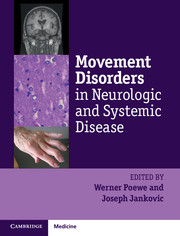Book contents
- Frontmatter
- Contents
- List of contributors
- List of videos
- List of abbreviations
- Preface
- Section I General principles
- Section II Movement disorders in systemic disease
- Chapter 4 Paraneoplastic movement disorders
- Chapter 5 Movement disorders of autoimmune origin
- Chapter 6 Movement disorders in systemic infections
- Chapter 7 Movement disorders in HIV- and AIDS-related central nervous system infections
- Chapter 8 Movement disorders in metabolic diseases in adulthood
- Chapter 9 Movement disorders in childhood metabolic diseases
- Chapter 10 Movement disorders in endocrinological diseases
- Chapter 11 Movement disorders in liver disease
- Chapter 12 Movement disorders in renal diseases
- Chapter 13 Movement disorders in hematological disease
- Section III Iatrogenic and toxic movement disorders
- Section IV Movement disorders in general neurology
- Section V Systemic complications of movement disorders
- Index
- Plate Section
- References
Chapter 5 - Movement disorders of autoimmune origin
from Section II - Movement disorders in systemic disease
Published online by Cambridge University Press: 05 April 2014
- Frontmatter
- Contents
- List of contributors
- List of videos
- List of abbreviations
- Preface
- Section I General principles
- Section II Movement disorders in systemic disease
- Chapter 4 Paraneoplastic movement disorders
- Chapter 5 Movement disorders of autoimmune origin
- Chapter 6 Movement disorders in systemic infections
- Chapter 7 Movement disorders in HIV- and AIDS-related central nervous system infections
- Chapter 8 Movement disorders in metabolic diseases in adulthood
- Chapter 9 Movement disorders in childhood metabolic diseases
- Chapter 10 Movement disorders in endocrinological diseases
- Chapter 11 Movement disorders in liver disease
- Chapter 12 Movement disorders in renal diseases
- Chapter 13 Movement disorders in hematological disease
- Section III Iatrogenic and toxic movement disorders
- Section IV Movement disorders in general neurology
- Section V Systemic complications of movement disorders
- Index
- Plate Section
- References
Summary
Introduction
Movement disorders (MDs) may present in a wide variety of autoimmune diseases affecting the nervous system. Some of these autoimmune disorders may be triggered by an infectious agent, such as Streptococcus in Sydenham’s disease, may occur in the setting of cancer, or with other autoimmune disorders associated with specific central nervous system (CNS) autoantibodies (Baizabal-Carvallo and Jankovic 2012). As infectious and paraneoplastic MDs will be reviewed elsewhere in this volume, they will not be included in this chapter.
In this chapter, we will review the MDs manifested as stiff person syndrome, encephalopathy associated with anti-thyroid antibodies, celiac disease, cerebral folate deficiency syndrome, systemic autoimmune and rheumatic diseases, and autoimmune vasculitis. The frequency of MDs varies according to the underlying disorder, and the phenomenology may be helpful to guide diagnostic tests of specific antibodies and treatment decisions. Table 5.1 provides a rapid overview of the most common autoimmune-related movement disorders.
Information
- Type
- Chapter
- Information
- Movement Disorders in Neurologic and Systemic Disease , pp. 52 - 72Publisher: Cambridge University PressPrint publication year: 2014
References
Accessibility standard: Unknown
Why this information is here
This section outlines the accessibility features of this content - including support for screen readers, full keyboard navigation and high-contrast display options. This may not be relevant for you.Accessibility Information
- 1
- Cited by
